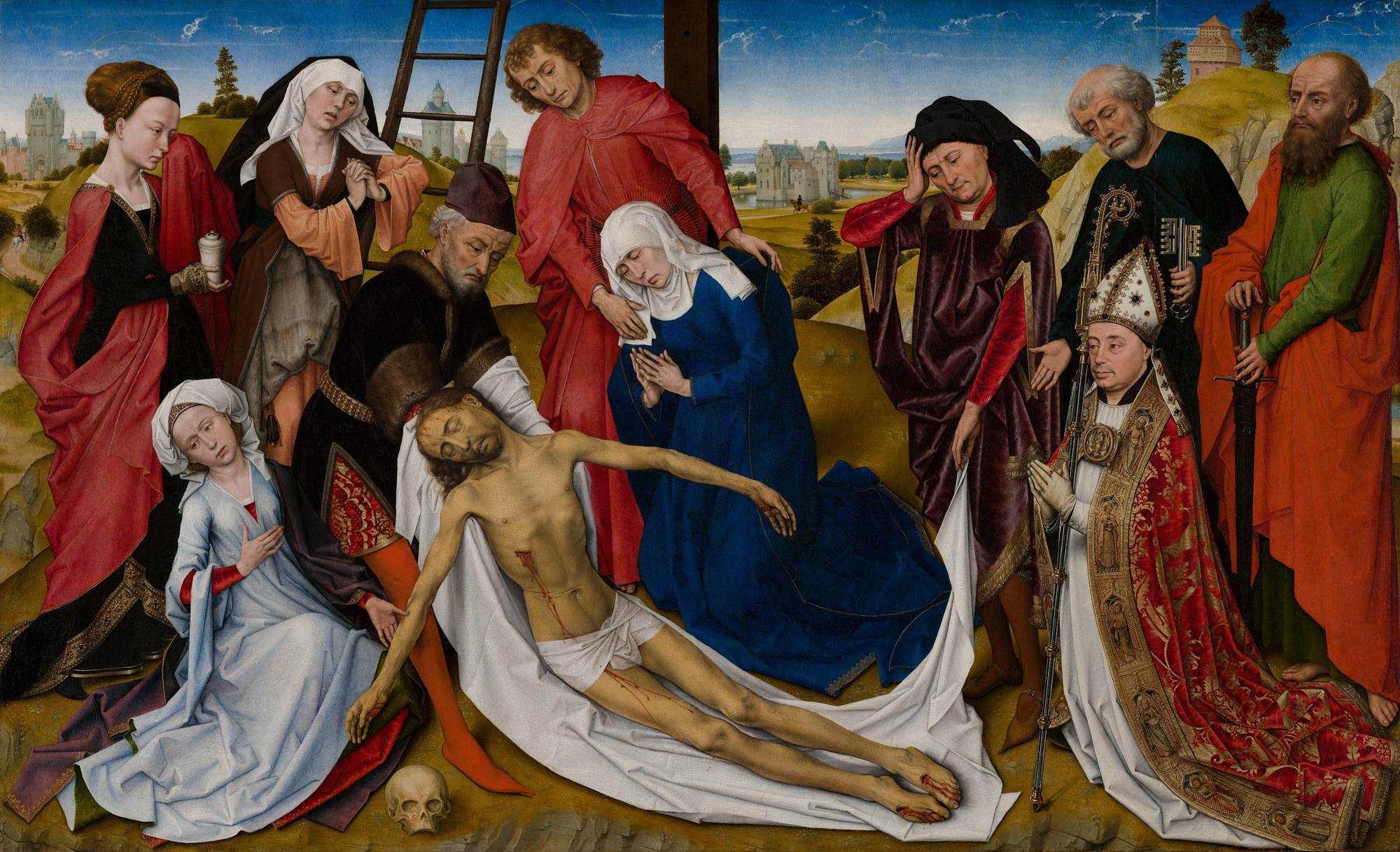The Lamentation of Christ by Rogier van der Weyden is the oldest painting in the Mauritshuis and the only work by the Brussels artist in a Dutch museum. The work was purchased for the Mauritshuis at a cost of 3,000 guilders in 1827. It was then believed to have been painted by Hans Memling, one of Van der Weyden’s pupils who was arguably more famous than his teacher in the nineteenth century. Two decades later the painting was attributed to Rogier van der Weyden. This attribution has meanwhile been generally accepted, although there can be no doubt that – as so often in Van der Weyden’s paintings – workshop assistants played a significant part in its execution.
Rogier van der Weyden is regarded as one of the most important Flemish painters of his day, second only to Jan van Eyck. The two artists were great innovators, chiefly due to the development of oil paints. By painting thin glazes of almost transparent oil paint, one on top of the other, they were able to achieve unprecedentedly intense colours. The technique also made it possible to handle the brush in a flowing manner, so the Flemish painters were able to work much more precisely. They transplanted scenes from the Bible to their own familiar surroundings, which they rendered with a wealth of lifelike detail. With his crystal-clear images, Jan van Eyck was unrivalled in his ability to create the illusion of a real world. Rogier van der Weyden added another important element to this naturalism: he painted emotions. His figures are moved to tears, cover their eyes or wring their hands as expressions of sorrow.
The projection of powerful emotions is the focus of The Lamentation. Immediately after Christ’s death, his followers lifted him down from the cross and lamented over his body. The crown of thorns was removed from his head, the blood from his wounds was staunched. The shape of the cross can still be seen in Christ’s outspread arms and pointed feet. Joseph of Arimathea supports the dead body, Nicodemus holds up one end of the shroud. According to the Bible, these two men would anoint and bury the body. At the heart of the composition, the weeping Virgin kneels beside her dead son, supported by St John. From the cross, Jesus had entrusted the care of his mother to his most beloved disciple. On the left, three holy women let their tears flow freely. One of them is Mary Magdalene (identified by her ointment jar), who dries her eyes with her cloak. On the right, by Christ’s feet, kneels a bishop, undoubtedly the man who commissioned the work. He is accompanied by St Peter (with the keys of heaven) and St Paul (with the sword used to behead him). The skull in the foreground is an allusion to Calvary, the site of the Crucifixion. The skull belongs to Adam, who was supposedly buried there. Van der Weyden’s Lamentation is set in a green, hilly landscape with Jerusalem in the distance on the left. The walled city and the other buildings in the background have very little to do with the Holy Land; the gatehouses, the castle with crenelated walls and the dovecote on the right look distinctly Flemish.
The bishop kneeling in prayer at the feet of the dead Christ is undoubtedly a portrait of the man who commissioned the painting, which would originally have served as an altarpiece in his church. Regrettably, it has not yet been possible to identify the bishop. Various suggestions have been made, among whom Pierre de Ranchicourt (1426?-1499) is the most likely candidate. It might perhaps explain why St Peter stands behind the bishop – he is his name saint. Should the identification be correct, the painting cannot have been made before 1463, the year Ranchicourt was ordained as Bishop of Arras. Since there are no known portraits of this bishop, his identity remains an open question.
Van der Weyden rendered the bishop’s episcopal robes in breath taking detail. The man wears a costly cope, white gloves with rings and a mitre set with gemstones. In the crook of his crosier there is an image of the Annunciation. A Christ, hand raised in blessing, flanked by two angels, adorns the clasp of the cope. The fact that the twelve apostles are depicted on the embroidered borders of the cope is significant. The bishop, after all, had followed in the footsteps of the apostles who spread the gospel after the Crucifixion. The presence of St Peter and St Paul behind the bishop could possibly be explained in that light: pictured together, the two represent the Jewish and the non-Jewish elements that go to make up the church. As the first Bishop of Rome, Peter also had a special significance: he was the most eminent predecessor of the man who commissioned the painting.
(this is a reworked version of the article ‘The Lamentation by Rogier van der Weyden’ by Ariane van Suchtelen, published in: Mauritshuis in Focus 31 (2) 2018, pp. 6-18)







